On the face of it, cellulose is the most mundane of biological products. Everyday cotton.
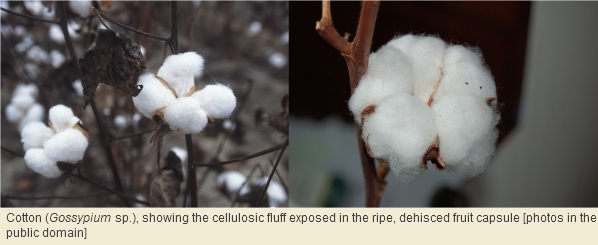
When you put on pyjamas of 100% cotton, you’re donning a product made simply from one natural polymer called cellulose, produced directly by plant cells, harvested by humans, and tweaked into shape as a garment without chemical transformation.
But a true understanding of the place of cellulose in Nature requires believing – a bit like the wonderland Queen – in five impossible things before doffing your pyjamas.

Here are five aspects of cellulose that hide in plain sight. As far as we know, biologists haven’t previously connected them.
Firstly, most[1] organisms that make cellulose cannot break this substance down. They can no more retrieve the energy in their own cellulose than you can eat your pyjamas. What is hiding in plain sight here is that this, in a way, makes trees quasi-zombies[2].
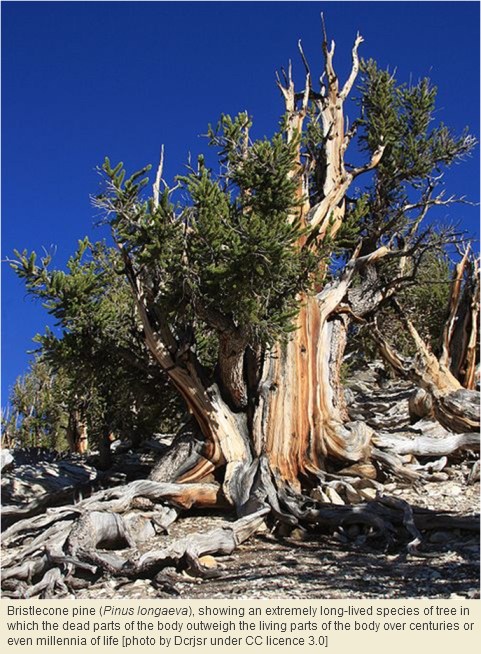
Delicious thought: even a century-old, juvenile bristlecone pine is already a quasi-zombie because more than half of its body is dead cellulose that will never live again even if the tree lives another thousand years.
Secondly, the largest organism that is known to be able to break down cellulose is a large snail. All herbivorous animals larger than this can only digest cellulose by means of friendly bacteria living inside their guts. What is hiding in plain sight here is that the world of herbivory is effectively created by the waste products of bacteria.
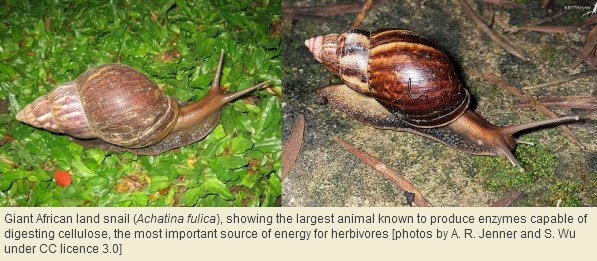
Delicious thought: yoghurt is twofold the fruit of bacterial wastes. The milk only flowed because the cellulose in grass was degraded by souring bacteria in the cow’s stomach; and then what grew in the milk itself was similar bacteria: Lactobacillus in both cases. You’re eating from the bacterial kitchen and bon appétit.

Thirdly, cellulose is chemically similar to chitin despite differing in nitrogen content. Although cellulose is usually thought of as the plant skeleton and chitin as the invertebrate skeleton, there is in fact no clear phylogenetic divide: some animals synthesise cellulose while fungi synthesise chitin instead of cellulose. What is hiding in plain sight here is that dragonfly wings, although animate, are as similar[3] chemically to cotton as tracing paper is.
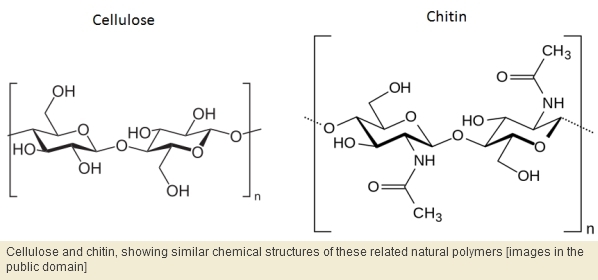
Delicious thought: When the horse turns to a diet of irruptive locusts to survive the loss of its grass to these insects in semi-arid Asia, it may experience this dietary break as a welcome feast of ‘flying grass’ in a biochemical sense[4]. Similarly, the wings that disperse butterflies and maple seeds are similar not only aerodynamically but also chemically.
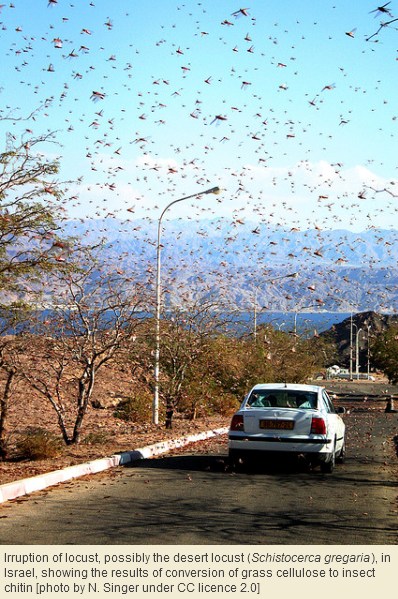
Fourthly, although plants can’t produce the enzyme required to break down the cellulose that they themselves have produced, they can produce the enzyme required to break down chitin, which they do not produce. Our explanation is that the enzyme called chitinase is useful to plants as a defence against fungal infections – since fungi use chitin as their main fibre. What is hiding in plain sight here is that this shows that the biochemical inability of woody plants to break down cellulose reflects a life tactic, not an inevitable biochemical barrier.
Delicious thought: Microbats[5] make their transparent wings from keratin, which they are powerless to break down. And they are no more able to synthesise cellulase[6] than any other mammal. Yet microbats are threefold able to break down chitin, the next-of-kin of cellulose, which they do not themselves produce. Firstly, they produce chitinase to fight the fungal diseases that threaten them in their dank caverns. Secondly, they secrete chitinase in their stomachs to digest e.g. moth scales. And thirdly, they produce chitinase symbiotically by means of gut bacteria to digest moth exoskeletons.
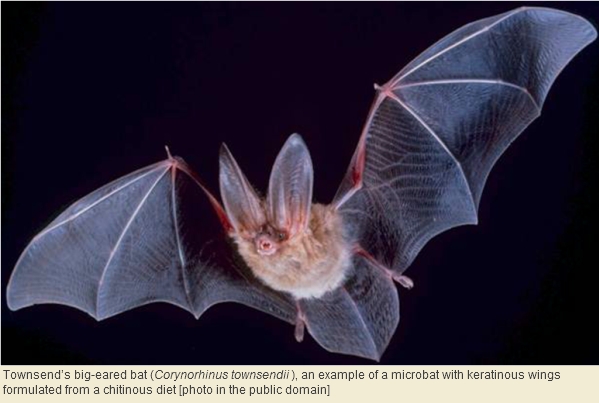
And fifthly, animals that eat a staple diet of invertebrates are functionally linked to herbivores rather than carnivores. Invertebrates, like plants, make for fibrous food and can only be digested thoroughly by means of friendly bacteria in the gut. What is hiding in plain sight here is that it’s no coincidence that aardvarks and blue whales have evolved from plant-eating ancestors rather than carnivorous ancestors.
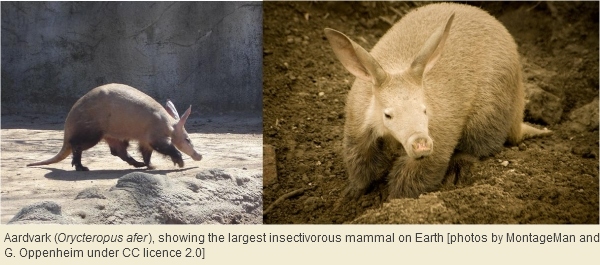
Delicious thought: The aardvark eats insects whereas hyraxes and sea cows eat plants, but the similarity of chitin to cellulose explains why all these mammals are classified as afrotherians with a common ancestor. Baleen whales eat krill whereas hippos eat mainly plants, but the similarity of chitin and cellulose explains why whales and hippos may share an ancestor, as opposed to whales sharing a carnivorous ancestor with, say, seals.

Two things dawn on us.
The line between animal and non-animal is less useful than it may seem; it’s a rather naive distinction that hides as much as it clarifies. If a Martian biologist called both cellulose and chitin ‘chitulose’ and regarded this as a single, somewhat variable form of fibre shared profoundly by plants, protists, fungi and animals, he might be ahead of us Earthians in real understanding.
Finally, it is a deep part of the life plan of plants to make themselves as much dead as alive. This is more fundamental, more interesting, and more pregnant with biological explanatory power than the naive, textbook observations that plants are the producers and fungi and animals the consumers, or that plants and many protists are photosynthetic while fungi and animals are not. A main biological feature – if not the main biological feature – of plants is not that they are inanimate but that they have a life strategy involving sequestering part of their own biomass, even as they live another day, in the form of dead cellulose from which they will never again retrieve even one Joule of the embodied energy.
***
All text and images appearing in this blog are subject to copyright, except those images explicitly stated to be in the public domain. You are not free to use any photographs, for any purpose, without receiving written permission from the copyright holder.
1 Animals are capable of producing cellulose, as shown by ascidians (Class Ascidiacea). Unlike plants, they seem able to break down their own cellulose enzymatically as part of normal growth, showing that the failure of plants do likewise is an evolutionary tactic rather than collateral to some insuperable barrier of biochemistry.
2 Most of the body of most mature trees is dead matter, called wood. Wood is not biomass but necromass, containing energy irretrievable to the plant that produced the wood and dead even when the tree is growing vigorously. It’s easy to take this for granted as an inevitable fact of plant biology, but this doesn’t stand up to scrutiny. Firstly, tall plants can be designed like bamboos, growing hollow rather than solid; secondly trees could have retained an enzymatic ability to autolyse wood for retrieval of the energy stored in wood, for example avoiding the wastage of shed branches; thirdly, trees such as various Australian eucalypts allow, and perhaps encourage, termites to hollow them out from below ground right up into the braches while they’re healthy and growing, thus recycling the lignified resources and still leaving a robust cylinder of wood for support; fourthly the wood may remain unburnt and undecomposed for years after a forest fire intense enough to kill the entire stand of trees; and fifthly the ecological advantages of trees over herbaceous plants, in the first place, remains enigmatic in terms of the most fundamental functions of this life form. Perhaps viewing trees as quasi-zombies will yield insights lacking in the past?
3 Insect wings consist of chitin strengthened by sclerotin, whereas tracing paper consists of cellulose strengthened by lignin.
4 The horse (Equus caballus) digests cellulose only superficially, so its failure to digest chitin is not necessarily a major departure from normality; horse dung of locust exoskeletons might look similar to normal horse dung. Although such fibre as the horse digestive system does ferment is cellulose, not chitin, a single line of bacteria, Lactobacillus, is capable of anaerobically degrading both polymers (as far as known, in different animals). If certain forms of Lactobacillus degrade cellulose endosymbiotically and other forms of Lactobacillus degrade chitin endosymbiotically, it’s possible that the Lactobacillus in the horse’s gut could morph enough to handle chitin for a while in a locust plague, actually fermenting chitin to some extent – bearing in mind that the guts of the eaten locusts may contain both types of Lactobacillus and therefore provide inoculum.
5 Microchiroptera
6 i.e. the enzyme which breaks down cellulose

